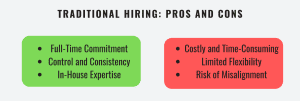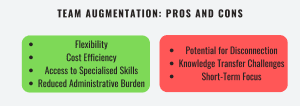Team Augmentation vs. Traditional Hiring
Introduction Organisations constantly face the challenge of finding the right talent to meet their evolving needs. Traditional hiring has long been the standard approach for b...

Introduction
Organisations constantly face the challenge of finding the right talent to meet their evolving needs. Traditional hiring has long been the standard approach for building and expanding teams, but in recent years, team augmentation has gained popularity as a flexible alternative. This article aims to provide a comprehensive comparison between team augmentation and traditional hiring, shedding light on the pros and cons of each approach to help readers make informed decisions.
Traditional Hiring
Traditional hiring, the tried-and-true method, involves posting job openings, conducting interviews, and onboarding full-time employees to meet specific skill and resource requirements. Here are some of the key advantages and disadvantages of this approach:

Pros of Traditional Hiring:
- Full-Time Commitment: When you hire full-time employees, you secure their exclusive dedication to your organisation. This ensures better integration into your company culture and long-term commitment.
- Control and Consistency: Traditional hires are under your direct supervision, allowing you to maintain control over their work and ensuring consistent progress toward your organisational goals.
- In-House Expertise: Employees hired through traditional methods often provide specialised skills and knowledge that can be valuable in the long run.
Cons of Traditional Hiring:
- Costly and Time-Consuming: Traditional hiring involves substantial costs related to recruitment, onboarding, benefits, and salaries. It can also be a time-consuming process, leading to delays in project execution.
- Limited Flexibility: Once hired, employees are committed to a fixed role and may not be easily adaptable to changing project requirements or seasonal workloads.
- Risk of Misalignment: If a full-time employee’s skills or goals do not align with the organisation’s changing needs, it can lead to inefficiencies and potential layoffs.
Team Augmentation
Team augmentation is a more flexible and agile approach that involves bringing in external talent or specialists on a temporary basis to complement your existing team. Here are the pros and cons of team augmentation:

Pros of Team Augmentation:
- Flexibility: Team augmentation allows you to scale your workforce up or down as needed, providing the flexibility to adapt to changing project requirements or market conditions.
- Cost Efficiency: You can control costs more effectively since you only pay for the expertise and time you need, without the overhead of full-time employment.
- Access to Specialised Skills: Team augmentation gives you access to a wider talent pool, including specialists with specific skills and experiences that may not be available in your local job market.
- Reduced Administrative Burden: When you work with an augmentation partner, they handle administrative tasks like hiring, payroll, and benefits, freeing you to focus on your core business.
Cons of Team Augmentation:
- Potential for Disconnection: Augmented team members may not have the same level of commitment to your organisation’s culture and long-term goals as full-time employees.
- Knowledge Transfer Challenges: Integrating external talent smoothly into your team may require additional effort to ensure knowledge transfer and effective collaboration.
- Short-Term Focus: Augmented team members are typically focused on specific project deliverables, which may not align with your long-term strategic objectives.
Conclusion
Choosing between team augmentation and traditional hiring depends on your organisation’s unique needs, resources, and goals. Traditional hiring offers stability and long-term commitment but can be costly and less flexible. On the other hand, team augmentation provides agility, cost-efficiency, and access to specialised skills but may require additional efforts in terms of integration and knowledge transfer.
The best approach often involves a combination of both methods. By strategically utilising team augmentation for short-term projects, seasonal workloads, or specialised skills, and complementing it with a core team of full-time employees, organisations can strike a balance between stability and flexibility, ultimately driving success in today’s dynamic business environment.
Ultimately, the choice between team augmentation and traditional hiring should align with your organisation’s current priorities and long-term vision, allowing you to make informed decisions that serve your business goals effectively.